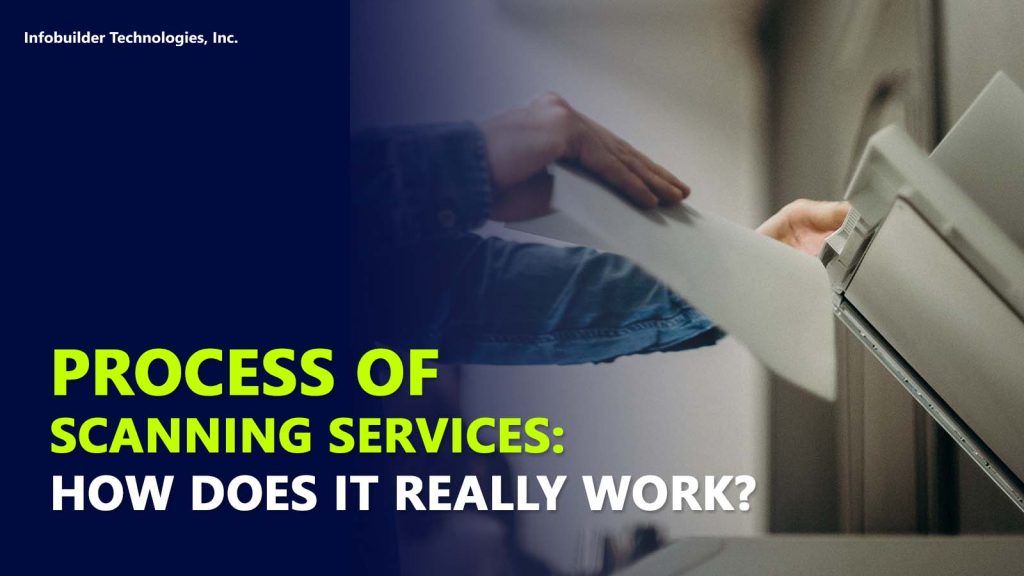Inspirations

Process of Scanning Services:
How Does It Really Work?
Posted on April 6, 2022
Whether you’ve already decided to digitize your documents or you’re still trying to see if it will indeed benefit your business, it will help to know how the scanning process actually works on a sizable scale. We understand that taking on a document scanning project may seem intimidating at first, but with a good scanning vendor, the process becomes a breeze.
Outsourcing your digitization needs takes the stress off of your hands, while giving you the peace of mind you need. However, fully understanding the imaging process from start to finish can give you a better idea of your specific wants and needs. Generally, the digitization process can be broken down into seven major steps:
Step 1: Prepping the Documents
We need to prepare the paper documents for scanning. Remove staples, paper clips, sticky notes (or tape them down so they can be scanned too); repair torn pages; and sort into batches.
Step 2: Conversion – Capture
After each document is correctly prepped, it is ready for scanning. Paper documents are then loaded into Scanning Equipment. During scanning, a good vendor will get a head start on quality control for your documents. Also during the process, a scanning technician oversees the pages as they scan to ensure that brightness and contrast settings are correct for a readable image. They’ll also ensure that no pages get double fed or missed during the scanning process.
Step 3: Image Cleanup
When documents are old or of poor quality, the quality of the digital copies can be improved with software or hardware image cleanup functionality. Common features include:
- Deskew – straightens images scanned in crooked
- Despeckle – removes dots from the document
- Rotate – turns documents fed in incorrectly to the right orientation
- Blank and double-page detection – blank pages can be deleted and a double-feed alert allows you to rescan the document
Step 4: Quality Control
After scanning, your documents undergo a thorough and rigorous quality control process. A technician reviews the images for readability, proper image orientation, blank pages to be deleted, and any other complications that may affect the quality of your project. Quality control is a critical part of the digitization process as it assures that your documents are easily readable, correctly indexed, and ready to be returned to you (or shredded).
Step 5: Indexing
Indexing is the step of the process that puts your data at your fingertips. If you don’t index your documents, you’ll never find them again! After scanning, each document is indexed according to your preferences. Each document can be indexed multiple ways in multiple categories to ensure that you can find what you need, when you need it. Typical index fields include: identification numbers, names, dates, locations, document types, service types, department names, and social security numbers. Though the options may seem varied and overwhelming, an experienced imaging vendor can help you determine the best option for your documents.
Step 6: Vouching
Vouching is the process of validating the scanned documents and associated index. The Voucher or Checker, attests that the scanned document is a faithful reproduction of the physical document that was scanned. The name of the vouching officer is included as part of the index and is associated with the digital document as it is saved or uploaded into a Document Management System (DMS).
Step 7: Uploading and Archival
After completing steps 1-6, the digital and physical documents can be processed as follows:
The Digital Copy can be uploaded into a DMS, saved to a CD/DVD/Hard Drive, or uploaded a repository on the cloud (Sharepoint, Google Drive, etc.)
Physical Copy may be boxed, indexed and saved to a document warehouse or sent to a service provider that handles document storage.
Now that your documents are digital, they’ll be easily accessible to anyone in your organization (if they have the right permissions, of course). Use them to automatically launch workflows, make customer service faster, or simply eliminate the need for filing cabinets. You can also dispose of the paper documents according to your business records management policy.
